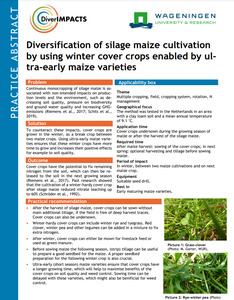{Tool} Diversification of silage maize cultivation by using winter cover crops enabled by ultra-early maize varieties (DiverIMPACTS Practice Abstract). [Diversificatie van de teelt van snijmaïs door het gebruik van groenbemesters, mogelijk gemaakt door ultravroege maïsrassen (DiverIMPACTS Practice Abstract).] Creator(s): Gorter, M.; Cuperus, Fogelina; Huiting, H. and Wesselink, M.. Issuing Organisation(s): WUR - Wageningen University & Research. (2020)
![[thumbnail of 2022-09-05 11_15_38-Protokoll.png]](/44441/1.hassmallThumbnailVersion/2022-09-05%2011_15_38-Protokoll.png)  Preview |
Image (PNG)
- Cover Image
- English
290kB |
|
PDF
- Published Version
- English
328kB | |
|
PDF
- Published Version
- Dutch/Nederlands
288kB |
Document available online at: https://zenodo.org/record/4061599#.YxW9wnZByUk
Summary in the original language of the document
Cover crops have the potential to fix remaining nitrogen from the soil, which can then be released into the soil in the next growing season. Past research showed that the cultivation of a winter-hardy cover crop after silage maize reduced nitrate leaching by up to 60%.
Summary translation
Groenbemesters hebben de potentie om resterende stikstof uit de bodem vast te leggen die vervolgens in het volgende groeiseizoen weer beschikbaar komt voor de vervolgteelt (Riemens et al., 2017). Eerder onderzoek toonde aan dat de teelt van een winterharde groenbemester na snijmaïs de nitraatuitspoeling tot 60% kan verminderde (Schröder et al., 1992).
| EPrint Type: | Practice tool |
|---|---|
| Teaser: | Learn more about fixing nitrogen and reducing nitrate leaching with winter-hardy cover crops. |
| What problem does the tool address?: | Continuous monocropping of silage maize is associated with non-intended impacts on production levels and the environment, such as decreasing soil quality, pressure on biodiversity and groundwater quality and increasing GHG-emissions. |
| What solution does the tool offer?: | To counteract these impacts, cover crops are grown in the winter, as a break crop between two maize crops. Using ultra-early maize varieties ensures that these winter crops have more time to grow and increases their positive effects for example to soil quality. |
| Country: | Netherlands |
| Type of Practice Tool: | Practice abstracts |
| Keywords: | maize, cover crops, winter hardiness, grass clover, rye, diversification, nitrogen fixation |
| Agrovoc keywords: | Language Value URI English grasses http://aims.fao.org/aos/agrovoc/c_3362 English cover crops -> cover plants http://aims.fao.org/aos/agrovoc/c_1936 English diversification http://aims.fao.org/aos/agrovoc/c_2344 English nitrogen http://aims.fao.org/aos/agrovoc/c_5192 English UNSPECIFIED UNSPECIFIED English UNSPECIFIED UNSPECIFIED English UNSPECIFIED UNSPECIFIED |
| Subjects: | Crop husbandry > Crop combinations and interactions Crop husbandry > Production systems > Cereals, pulses and oilseeds |
| Research affiliation: | European Union > Horizon 2020 > Diverimpacts Netherlands > Wageningen University & Research (WUR) European Union > Organic Farm Knowledge |
| Horizon Europe or H2020 Grant Agreement Number: | 727482 |
| Related Links: | https://organic-farmknowledge.org/tool/44441, https://twitter.com/farm_knowledge/status/1621207932636471297, https://www.facebook.com/organicfarmknowledge/posts/pfbid02ua8WtkeSbFxzjs7tvE5A2vsueaFUjJHQ1GGjX4g8EJspmKfxSX6m8Rb5FT9GeJy5l |
| Project ID: | OFK |
| Deposited By: | Rüger, Madelaine Lea |
| ID Code: | 44441 |
| Deposited On: | 19 Sep 2022 14:12 |
| Last Modified: | 02 May 2024 10:32 |
| Document Language: | English, Dutch/Nederlands |
| Status: | Published |
Repository Staff Only: item control page

 Download Statistics
Download Statistics Download Statistics
Download Statistics
